Publisher: Amy Marson
Creative Director: Gailen Runge
Art Director/Cover Designer: Kristy Zacharias
Editor: Liz Aneloski
Technical Editor: Nan Powell
Book Designer: Christina Jarumay Fox
Production Coordinator: Freesia Pearson Blizard
Production Editor: Katie Van Amburg
Illustrators: Kirstie Pettersen, Tim Manibusan, Gretchen Schwarzenbach, Richard Sheppard, Rose Sheifer, Alan McCorkle, Jay Richards, and Jenny Davis
Photography: Diane Pedersen, Nissa Brehmer, Christina Carty-Francis, Luke Mulks, Sharon Risedorph, John Bagley, and Richard Tauber, unless otherwise noted.
Photo Assistant: Mary Peyton Peppo
Published by C&T Publishing, Inc., P.O. Box 1456, Lafayette, CA 94549

This book would not have been possible without the great community of quilting teachers who have inspired and educated us over the past several decades. Thank you, ladies and gentlemen, for elevating our craft to an unparalleled level of excellence. This book is dedicated to you and to those who are just now discovering the wonderful world of quilting. May this book be an integral part of your journey as you find your own personal voice in cloth.

My sincere thanks to:
RJR Fabrics and Valori and Jean Wells of the Stitchin Post (Sisters, Oregon), who graciously provided glorious fabric to work with;
BERNINA, for letting me play with and create using their terrific sewing machines;
Bob and Heather Purcell of Superior Threads, for their excellent products and their continued effort to educate the masses about the wonderful world of thread;
Olfa Products, for great tools to work with;
Carolie Hensley at The Cotton Patch (Lafayette, California) for her continued support;
Liz Aneloski at C&T Publishing, for being an editorial superstar;
Erica von Holtz, for her eagle eye;
Pam Vieira-McGinnis, just for being there;
and last, but not least, Darra Williamson, who helps me keep my ducks in a row!

 One of the great things about quilting is that the creative journey never ends. The same can be said of the quilters learning curve. There are loads of opportunities to expand our knowledge and a zillion ways to address the process. Since the 1997 publication of my book Start Quilting with Alex Anderson (now in its third edition), Ive gone on to create an extensive series of little books, each aimed at teaching a specific skill.
One of the great things about quilting is that the creative journey never ends. The same can be said of the quilters learning curve. There are loads of opportunities to expand our knowledge and a zillion ways to address the process. Since the 1997 publication of my book Start Quilting with Alex Anderson (now in its third edition), Ive gone on to create an extensive series of little books, each aimed at teaching a specific skill.
At a recent Quilt Market, a shop owner asked me if there were a book currently in print that encompasses all the subjects Ive targeted in my little books. Bingo! Lightbulb moment! Perhaps the time had arrived for me to produce a big book of quiltinga perfect, one-stop resource guide for quilters. You now hold that book in your hands.
As I began to pull this big book together, I recognized that many things about the quiltmaking process have remained the same, anchored by tried-and-true theories and techniques that have stood the test of time. They worked then, and they work now.
Quilting, however, is not a static endeavor. As with any craft, the materials and methods have continued to evolve. In this book, Ive kept the best from my little books, while updating and expanding the information they contain. Ive also added new material that Ive never covered in my books before. My ultimate wish is that you consider this book your all-in-one, go-to place when seeking information to inform and improve your quilting.
I love meeting other quilters and am always flattered and humbled when Im asked to autograph one of my books. I hope someday that I get to meet you andshould you present this book for me to signthat your book shows all the signs of the love, wear, and tear that signal a well-used favorite.
Until we meet (and we quilters do get around),
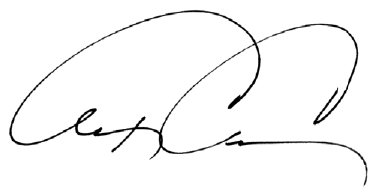

A quilt is like a sandwich. It has three layers:
 The quilt top is made of fabrics (usually 100% cotton) cut in various sizes and then sewn together either by hand or machine to create the overall quilt design.
The quilt top is made of fabrics (usually 100% cotton) cut in various sizes and then sewn together either by hand or machine to create the overall quilt design.
 The batting is the filler between the quilt top and the backing. It forms the middle layer of the quilt sandwich. It is typically cotton, polyester, or a blend of both.
The batting is the filler between the quilt top and the backing. It forms the middle layer of the quilt sandwich. It is typically cotton, polyester, or a blend of both.
 The backing is the bottom layer of the quilt sandwich. It can be made up of a single piece of fabric or pieced to achieve the appropriate width.
The backing is the bottom layer of the quilt sandwich. It can be made up of a single piece of fabric or pieced to achieve the appropriate width.
Quilting is the act of stitching all three layers together by hand or machine.
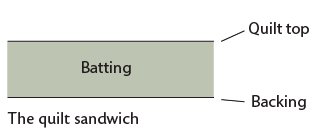
The following terms describe the various parts of the quilt surface.
 The block is the basic unit of quilt construction. Many quilts are made up of multiple, repeated blocks, arranged in rows to form the body (or center) of the quilt.
The block is the basic unit of quilt construction. Many quilts are made up of multiple, repeated blocks, arranged in rows to form the body (or center) of the quilt.
 When blocks or borders are pieced , individual fabric shapes are seamed together to create an overall motif.
When blocks or borders are pieced , individual fabric shapes are seamed together to create an overall motif.
 When blocks or borders are appliqud , individual shapes are stitched on top of a base fabric to create an overall motif.
When blocks or borders are appliqud , individual shapes are stitched on top of a base fabric to create an overall motif.
 Sometimes called lattice, sashing refers to fabric strips sewn between blocks to form a grid over the surface of the quilt center. In addition to separating the blocks, the choice of sashing fabric often allows these strips to create interesting secondary patterns, particularly when paired with cornerstones at each juncture.
Sometimes called lattice, sashing refers to fabric strips sewn between blocks to form a grid over the surface of the quilt center. In addition to separating the blocks, the choice of sashing fabric often allows these strips to create interesting secondary patterns, particularly when paired with cornerstones at each juncture.
 A quilts border acts as a frame. The border should make sense visually; that is, it should relate to or add something to the quilts overall design. It might repeat or emphasize a key color, fabric, block, or other element in the quilts body.
A quilts border acts as a frame. The border should make sense visually; that is, it should relate to or add something to the quilts overall design. It might repeat or emphasize a key color, fabric, block, or other element in the quilts body.
Sometimes a quilt will have more than one border. In addition to meeting the criteria above, multiple borders should be scaled in pleasing proportion to one another, as well as to the overall quilt. Along with sashing and cornerstones, youll learn more about border options in Putting It Together: Settings and Borders.
Next page
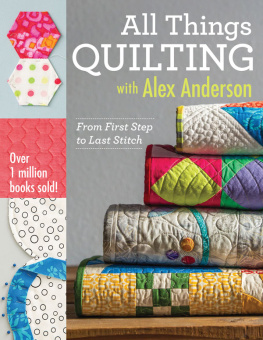

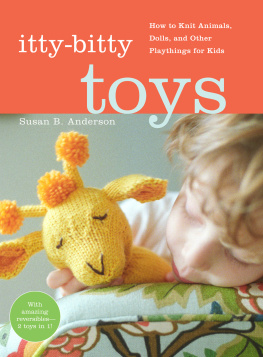
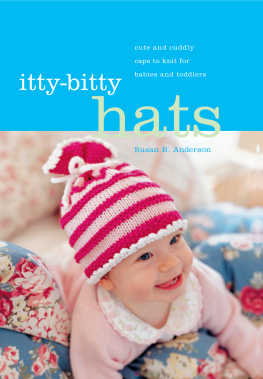

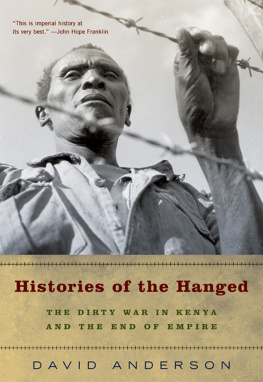
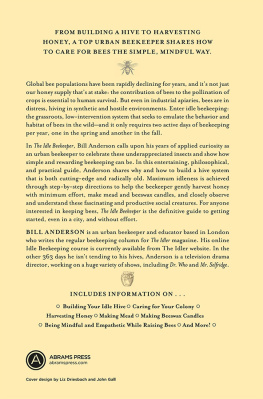
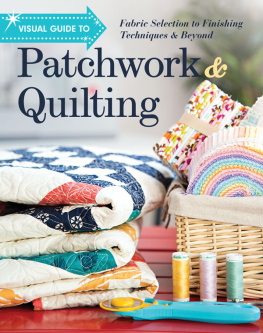
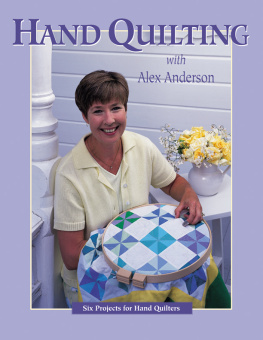

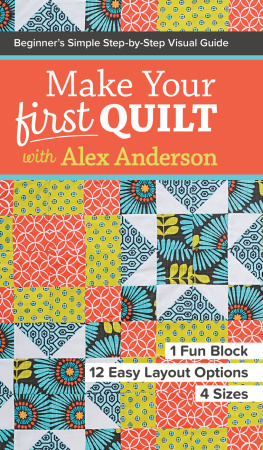

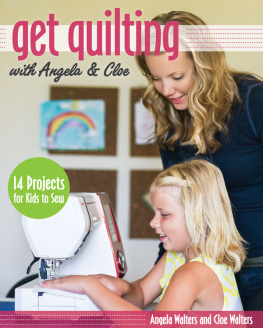
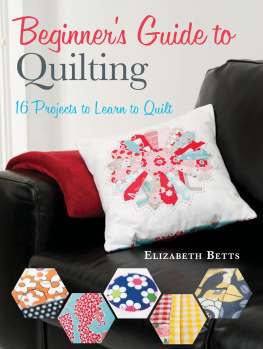
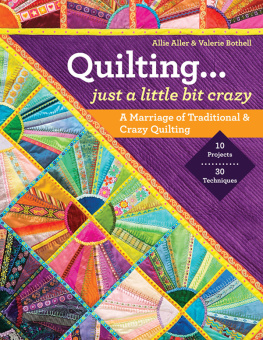

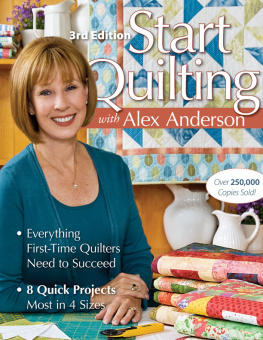
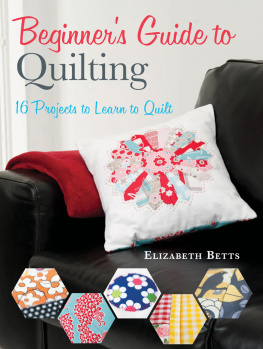



 One of the great things about quilting is that the creative journey never ends. The same can be said of the quilters learning curve. There are loads of opportunities to expand our knowledge and a zillion ways to address the process. Since the 1997 publication of my book Start Quilting with Alex Anderson (now in its third edition), Ive gone on to create an extensive series of little books, each aimed at teaching a specific skill.
One of the great things about quilting is that the creative journey never ends. The same can be said of the quilters learning curve. There are loads of opportunities to expand our knowledge and a zillion ways to address the process. Since the 1997 publication of my book Start Quilting with Alex Anderson (now in its third edition), Ive gone on to create an extensive series of little books, each aimed at teaching a specific skill.

 The quilt top is made of fabrics (usually 100% cotton) cut in various sizes and then sewn together either by hand or machine to create the overall quilt design.
The quilt top is made of fabrics (usually 100% cotton) cut in various sizes and then sewn together either by hand or machine to create the overall quilt design. The batting is the filler between the quilt top and the backing. It forms the middle layer of the quilt sandwich. It is typically cotton, polyester, or a blend of both.
The batting is the filler between the quilt top and the backing. It forms the middle layer of the quilt sandwich. It is typically cotton, polyester, or a blend of both. The backing is the bottom layer of the quilt sandwich. It can be made up of a single piece of fabric or pieced to achieve the appropriate width.
The backing is the bottom layer of the quilt sandwich. It can be made up of a single piece of fabric or pieced to achieve the appropriate width.
 The block is the basic unit of quilt construction. Many quilts are made up of multiple, repeated blocks, arranged in rows to form the body (or center) of the quilt.
The block is the basic unit of quilt construction. Many quilts are made up of multiple, repeated blocks, arranged in rows to form the body (or center) of the quilt. When blocks or borders are pieced , individual fabric shapes are seamed together to create an overall motif.
When blocks or borders are pieced , individual fabric shapes are seamed together to create an overall motif. When blocks or borders are appliqud , individual shapes are stitched on top of a base fabric to create an overall motif.
When blocks or borders are appliqud , individual shapes are stitched on top of a base fabric to create an overall motif. Sometimes called lattice, sashing refers to fabric strips sewn between blocks to form a grid over the surface of the quilt center. In addition to separating the blocks, the choice of sashing fabric often allows these strips to create interesting secondary patterns, particularly when paired with cornerstones at each juncture.
Sometimes called lattice, sashing refers to fabric strips sewn between blocks to form a grid over the surface of the quilt center. In addition to separating the blocks, the choice of sashing fabric often allows these strips to create interesting secondary patterns, particularly when paired with cornerstones at each juncture. A quilts border acts as a frame. The border should make sense visually; that is, it should relate to or add something to the quilts overall design. It might repeat or emphasize a key color, fabric, block, or other element in the quilts body.
A quilts border acts as a frame. The border should make sense visually; that is, it should relate to or add something to the quilts overall design. It might repeat or emphasize a key color, fabric, block, or other element in the quilts body.